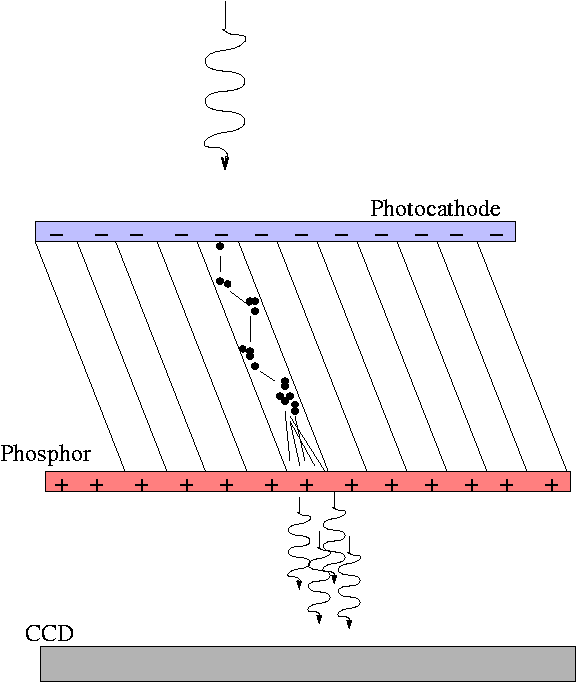
 Copyright © Michael Richmond.
This work is licensed under a Creative Commons License.
Copyright © Michael Richmond.
This work is licensed under a Creative Commons License.
The photoelectric effect -- a single packet of light/energy giving its energy to a single electron -- is the basis for electronic cameras. Let's look at two different types of cameras in detail:
The first type uses the photoelectric effect once; the second type employs it twice, in order to build up a stronger signal when light levels are low.
The term CCD stands for Charge-Coupled Device. It is basically a thin wafer of silicon with an array of electrodes glued to its front (or back).
The basic idea is that silicon, a SEMI-conductor, has two types of electrons:
When a photon strikes the CCD, it may excite a single valence electron into the conduction band, allowing it to move freely. The conduction electrons can then be shepherded to a readout amplifier by the electrodes.
This works fine in ordinary situations. But when the light levels are very low, CCD cameras are overwhelmed by noise. If only one photon strikes the camera during a frame, producing one electron, but 10 electrons are knocked free by thermal motions of the atoms during the same time, the picture will be lost.
Is there any way to amplify the light signal, so that it will stand out above the noise? The answer is "yes" -- in fact, there are several schemes to do it.
One of these methods involves MicroChannel Plates, or MCPs.
Here's the basic idea:

A typical intensifier can turn a single input photon into tens of thousands of output photons! The ratio between the number of photons striking the front of the MCP and the number of photons coming out the back end is called the gain of the device. Expensive MCPs may have gains as large as 50,000.
The big advantage of intensified cameras is that they show lots of detail even at low light levels. For every one incoming photon from the scene, the MCP produces thousands of photons. Thus, the signal-to-noise ratio is much higher than in an ordinary camera when light levels are low.
S/N in situations with little input light
====================================================================
ordinary camera intensified camera
--------------------------------------------------------------------
number of
photons 2 2
from scene
Signal =
number of 2 20,000
electrons
produced
Noise =
number of
electrons 5 5
from thermal
noise
---------------------------------------------------------------------
Signal/Noise 0.4 4,000
=====================================================================
The disadvantage of these systems is that they can saturate and "white-out" when they encounter lots of light -- such as those found outside during the day, or under a streetlight.
 Copyright © Michael Richmond.
This work is licensed under a Creative Commons License.
Copyright © Michael Richmond.
This work is licensed under a Creative Commons License.